This Week in Space: Honors Aboard the International Space Station
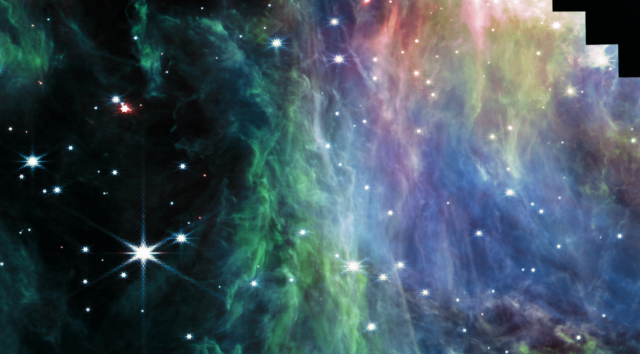
Happy Friday, dear reader. Welcome back to This Week in Space, where we round up the major happenings from LEO to the Oort Cloud and all points west. NASA is still working to get the Artemis moon rocket into the air, but they’ve set another launch date. In contrast, the European Space Agency will make history next week when Samantha Cristoforetti becomes commander of the International Space Station. Here on Earth, scientists have proposed a surprising reason for the rings of Saturn. We’ll also cast an eye on what’s happening skyward, and check in with Perseverance and Ingenuity as they explore Mars.
Samantha Cristoforetti to Become First European Female ISS Commander
Mission specialist Samantha Cristoforetti was already a decorated pilot and veteran astronaut when she came aboard the International Space Station (ISS) in April of this year. But after demonstrating outstanding leadership on Earth and in space, Cristoforetti is about to get another promotion. Later this month, Spc. Cristoforetti will become commander of the International Space Station.
Cosmonaut Oleg Artemyev, the current commander of the ISS, will hand over leadership of the station to Cristoforetti in a formal ceremony on Wednesday, Sept. 28. If you want to watch, the European Space Agency will be live-streaming it from space on their YouTube channel, ESA Web TV.
This is Cristoforetti’s second stay on the ISS. On her first trip, she set the record for the longest stay in space for a woman, after she spent 199 days in low-earth orbit in 2014 and 2015. Upon taking her new role, Cristoforetti will become the fifth European commander of the Space Station. She will also be not just the first Italian female, but the first European female, to hold the position.
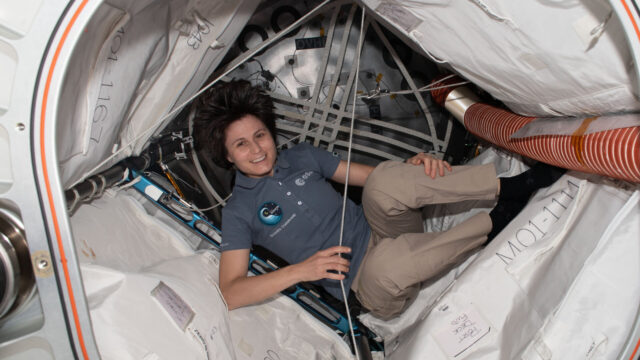
Samantha Cristoforetti inside the BEAM inflatable module, aboard the International Space Station. Image: Samantha Cristoforetti / ESA
Since Cristoforetti will take command in the final weeks of her stay aboard the space station, one of her major duties will be to ensure a smooth handover to future expeditions.
“I am humbled by my appointment to the position of commander,” said Cristoforetti, “and look forward to drawing on the experience I’ve gained in space and on Earth to lead a very capable team in orbit.”
Saturn’s Rings May Be the Remains of an Ancient Moon
The rings of Saturn have fascinated humanity since early telescopes became powerful enough to see them. The Dutch astronomer Christiaan Huygens was the first to spy their true nature in 1655. According to Huygens, “[Saturn] is surrounded by a thin, flat, ring, nowhere touching, inclined to the ecliptic.”
Originally, astronomers believed Saturn’s rings were just as old as the planet itself. Early studies suggested that the rings either coalesced out of the planetary nebula at the same time as Saturn, or that they formed during the chaotic Late Heavy Bombardment period early in the life of our solar system. But later observations of Saturn and Jupiter concluded that rings around a planet are a transient feature made of dust and debris. As the debris is lost to space, the rings disappear.
Now, a new analysis of data from Cassini indicates that Saturn’s rings are roughly 100 million years old — much younger than the planet they orbit. There were already dinosaurs thriving on Earth at this point in time. We were mostly done with giant impacts. So, if Saturn’s rings are so young, what formed them in the first place?
‘An Additional Satellite, Which We Name Chrysalis’
This new paper analyzed data from Cassini’s 13-year mission and found that orbital interactions with Titan, Saturn’s largest moon and the only moon in the solar system covered in a thick atmosphere, aren’t enough to explain Saturn’s orbital tilt. Instead, in their report, the astronomers propose “an additional satellite, which we name Chrysalis.”
“The tilt is too large to be a result of known formation processes in a protoplanetary disk or from later, large collisions,” said lead study author Jack Wisdom in a statement. “A variety of explanations have been offered, but none is totally convincing. The cool thing is that the previously unexplained young age of the rings is naturally explained in our scenario.”
In this scenario, Chrysalis had orbital interactions with both Neptune and Saturn. The gravitational forces both tilted Saturn’s axis and eventually destroyed Chrysalis itself. Most of the ruined moon would have fallen into Saturn. However, a fraction of the moon’s debris would have remained in orbit, forming the planet’s famous rings.
From Perseverance, With Love
Thursday afternoon, NASA held a briefing on how Perseverance is holding up on Mars. The rover is busy exploring a “geologically rich” area of the Three Forks river delta. Right now, Perseverance is collecting samples from Skinner Ridge, a feature carved out while the delta was forming. Meanwhile, Ingenuity is resting from its most recent flight, Flight 31, on Sept. 6.
[embedded content]
Flight 31 was the space copter’s second flight since mission scientists grounded it in June, to protect it from the Martian winter. While it’s only four months long, the dust storms and bitter cold of winter pose a real threat.
Sadly, no word on Perseverance’s pet rock.
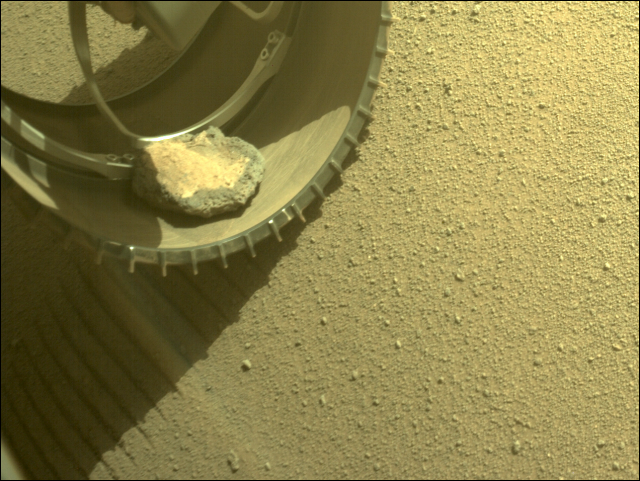
NASA’s Mars Perseverance rover acquired this image of Perseverance’s pet rock using its onboard Front Left Hazard Avoidance Camera A. Image Credit: NASA/JPL-Caltech
Perseverance picked up its passenger sometime this spring. We only found out about it after it had been tumbling along inside the rover’s wheel for some months. Here’s to you, little dude.
NASA Announces Updated Artemis 1 Launch Windows
After scrubbing two launches of the Space Launch System moon rocket in quick succession, NASA is evidently hoping that the third time’s the charm. The agency has outlined a new launch window for Artemis 1, the inaugural mission of the Space Launch System rocket.
After repairs to the rocket’s hydrogen systems, Artemis launch control set a date for a pre-launch fueling demonstration: Sept. 21. If all goes well, the SLS will launch during a 70-minute window that opens Sept. 27 at 11:37 AM EDT. However, for all the reasons, NASA has a backup launch date on Oct. 2.
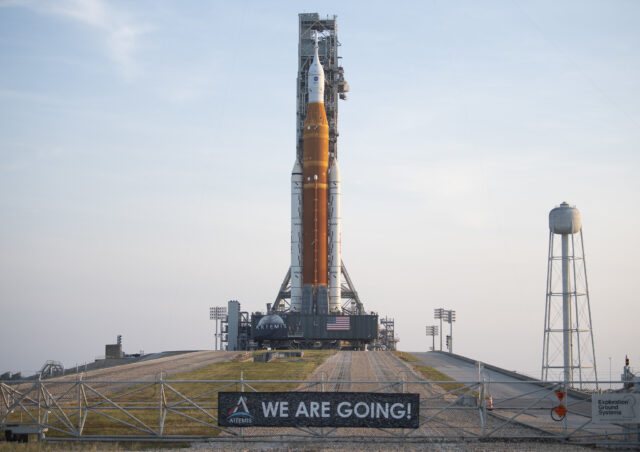
NASA’s Artemis I mission is the first integrated test of the agency’s deep space exploration systems: the Orion spacecraft, SLS rocket, and supporting ground systems. Image credit: NASA/Joel Kowsky
Over the weekend, Artemis I teams completed repairs on the area of a hydrogen leak. NASA said in a blog post, “Engineers reconnected the ground- and rocket-side plates on the quick disconnect for the liquid hydrogen fuel feed line, where two seals were replaced last week. This week, teams will conduct tests at ambient conditions to ensure there is a tight bond between the two plates before testing again during the cryogenic tanking demonstration.”
Hydrogen remains about as hard to deal with as Congress, so we’ll see if the agency can get it right in time.
Space Telescope Eye Candy From Hubble and Webb
You know what’s great? Space telescopes. They sail placidly above the Earthly noise and haste, periodically sending us beautiful and useful pictures of the night sky. Here are the highlights from this week:
Hubble ‘Studies a Spectacular Spiral’
To start with, we’ve got this beautiful Hubble image of NGC 1961, an intermediate spiral galaxy. Located about 180 million light-years away, NGC 1961 resides in the constellation Camelopardalis.
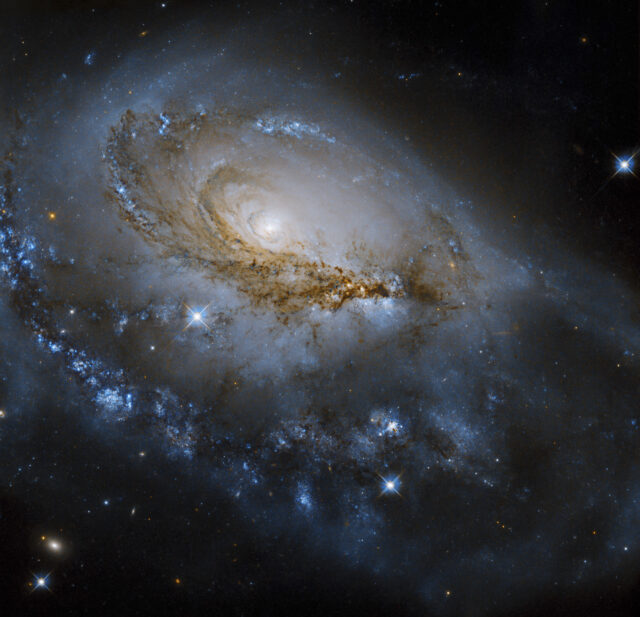
Image credit: NASA, ESA, J. Dalcanton (University of Washington), R. Foley (University of California – Santa Cruz); Image processing: G. Kober (NASA Goddard/Catholic University of America)
This type of galaxy doesn’t have an organized bar or spiral structure. What it does have is an active galactic nucleus, or AGN: a supermassive black hole at its center.
New Images From Webb Show Secrets of Star Formation
Not to be outdone, the James Webb space telescope captured images of the Orion Nebula on Sunday (Sept. 11), and we already have the breathtaking results. My colleague Ryan Whitwam wrote, “As you can see below, Webb can see stars that were completely obscured in Hubble images. It also captures much more detail of the cloud structure, including delicate filaments that are rich in hydrocarbon molecules and molecular hydrogen.”
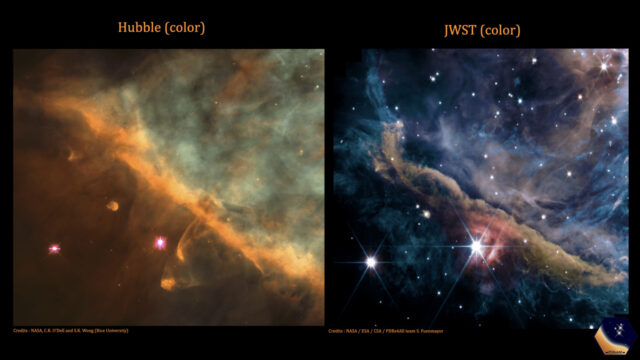
Credit: NASA, ESA, CSA, PDRs4All ERS Team; image processing Olivier Berné.
Credit for the HST image: NASA/STScI/Rice Univ./C.O’Dell et al. – Program ID: PRC95-45a.
Some of the stars in these images are so young they’re just beginning to blow a “bubble” around themselves with their stellar wind. Others even show evidence of protoplanetary disks: chunks of gas, dust, rock, and metal that form a spinning disk much more massive than Saturn’s rings. If they don’t disperse, these disks will coalesce into planets in a few million years.
Here’s another image from this set: the full version of this article’s feature image. It’s a close-up of another region of the Orion Bar, taken with Webb’s NIRCam instrument.
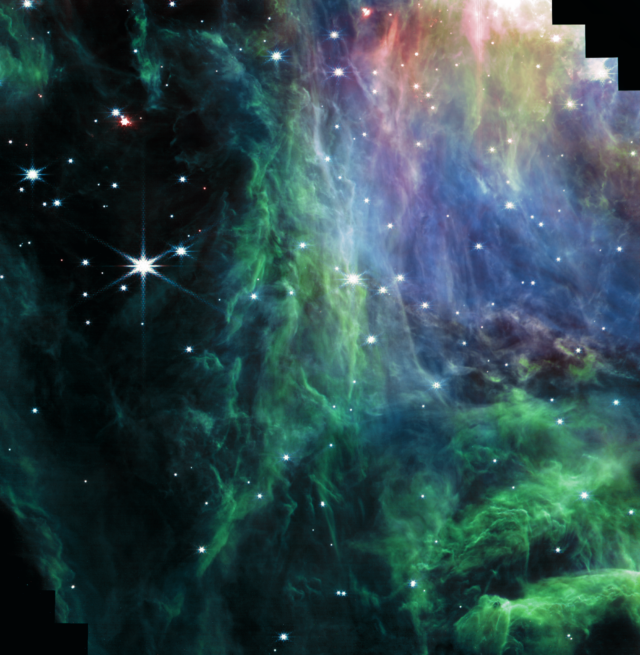
Northern region of M42 observed with detector A of NIRCam during observation of the Orion Bar. Image: PDRs4All
The reason we get such elegant images from the James Webb telescope is its outstanding resolution. The telescope has a truly gigantic mirror, which means it has excellent angular resolution; it can see things clearly even at great distance. But its sensitive instruments also give it outstanding spectral resolution. Webb’s MIRI and NIRCam instruments are infrared cameras, high-resolution CCDs that can zero in on specific wavelengths of light in the infrared band. Using these very specific observations, scientists can peer through the veil of dust and see what’s going on inside features like the Orion Nebula.
To get a sense of the improvement, check out this side-by-side comparison of what the Spitzer and Webb space telescopes see when looking at the same patch of sky, elsewhere in the nebula:
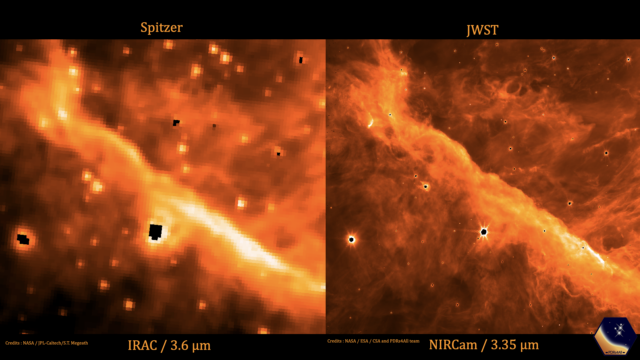
Credits for NIRCam image (left): NASA, ESA, CSA, PDRs4All ERS Team; image processing Olivier Berné. Credit for the Spitzer image: NASA/JPL-Caltech/T. Megeath (University of Toledo, Ohio)
The black spots in these colorized images are places where the light was so bright that the pixels in the CCD were fully saturated: you can’t get brighter than white, so the pixel value overran its range and flipped back around to black. It’s not unlike Michael Bay lens flare. But these images also show how much better the JWST’s vision is than its predecessors. Here’s another comparison between Webb and Spitzer, this one animated:
Can you spot the difference?
Skywatchers Corner
Wednesday of this week was the shortest solar day of the year. NASA skywatching expert Preston Dyches explains the solar day, the motion of Mars, and other phenomena, in NASA’s “What’s Up” for September stargazers.
[embedded content]
Jupiter is still at opposition, exactly on the other side of the Sun as seen from Earth. This means the planet is fully illuminated by sunlight, and its rings and larger moons are on brilliant display. It should stay this way through the rest of September.
In closing, just an idea — Wouldn’t it be nice to spend the evening of the autumn equinox, Sept. 22, stargazing? The equinox falls at 9:03 PM EDT on the evening of the 22nd. All through this month, Saturn and Jupiter will be visible in the evening sky.
Thanks for reading, friends and fellow space nerds. See you next week.

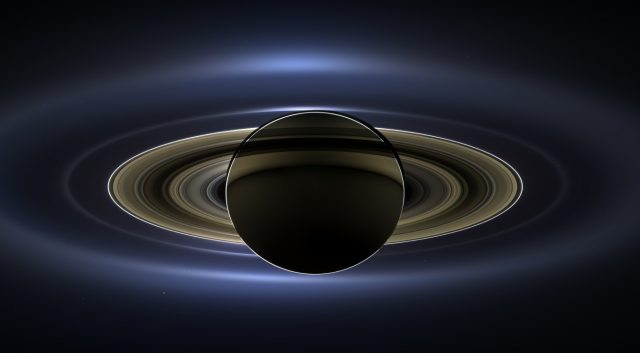

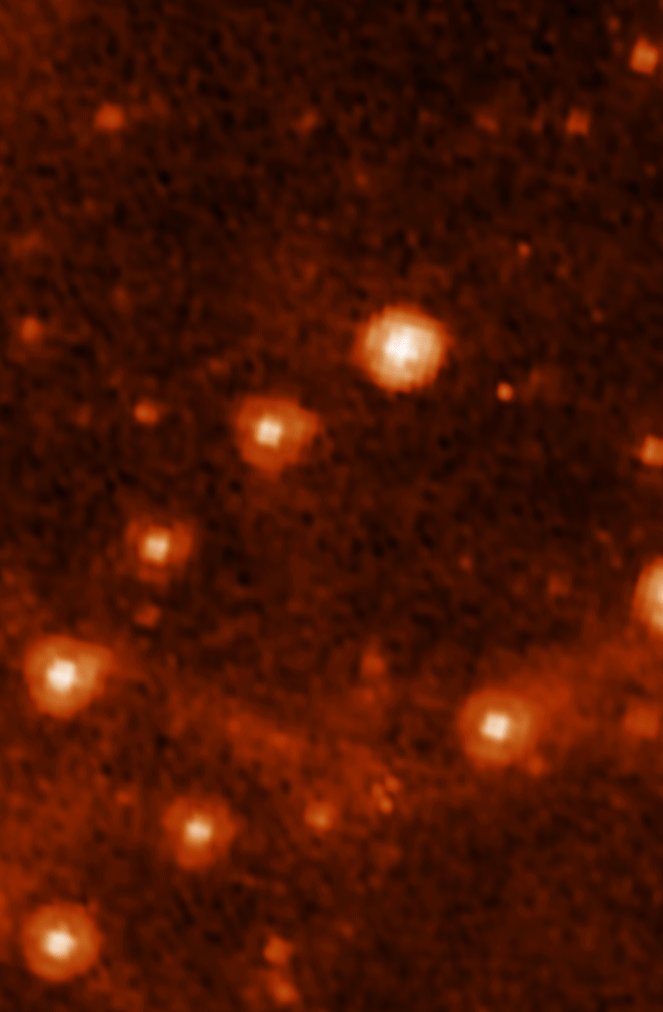
Comments are closed.